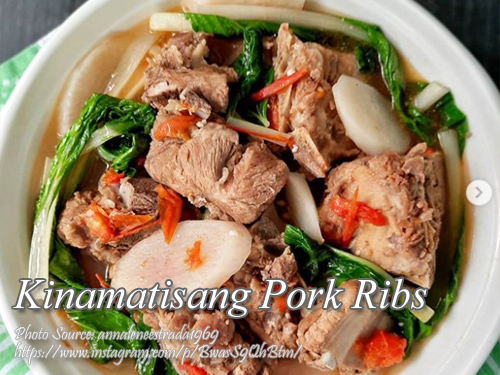How to Cook Kinamatisang Pork Ribs
Kinamatisang pork ribs is a comforting Filipino soup made with tender pork simmered in a broth of ripe tomatoes, radish, and leafy greens for a balanced, hearty flavor.
Prep Time10 minutes mins
Cook Time35 minutes mins
Course: Pork Recipe
Cuisine: Filipino
Keyword: easy kinamatisang baboy, Filipino pork tomato soup, kinamatisang buto buto, kinamatisang pork ribs, pork bone soup Filipino style, pork ribs with tomatoes
Servings: 4 servings
Calories: 235kcal
Author: Manny
- 1 kilo pork ribs
- 3/4 kilo very ripe tomatoes chopped
- 2 pcs white onions chopped
- 2 to 3 cloves garlic minced
- 1 tsp. salt
- 1 piece white radish sliced diagonally
- 2 bunches pechay
- 1 Tbsp. patis
- 1/4 cup cooking oil
How to Cook Kinamatisang Pork Ribs
Heat cooking oil in a wok or pot over medium heat. Saute onions, and garlic until the onion is tender.
Add in the tomatoes and saute for a minute then pour patis. Then cover and simmer until the tomatoes are tender.
Add the pork ribs and saute until the pork changes color. Cook for about 3 to 5 minutes.
Add 1.5 liters water and bring to a boil. Lower heat and cover. Simmer for 20 minutes or until meat is fork tender.
Add in the radish and simmer for 10 more minutes.
Before serving, add pechay and let it cook for 1 to 2 minutes and season with salt if needed. Serve hot.
Cooking Tips:
Use Ripe Tomatoes for Depth of Flavor
Choose fully ripe and juicy tomatoes to give the broth its natural sweetness and tang. Unripe ones will make the soup taste flat, while overripe tomatoes might turn mushy too quickly. If you want a richer flavor, you can roast the tomatoes before adding them to the pot.
Simmer the Ribs Low and Slow
Allow the pork ribs to cook gently over low heat to release their natural flavors and collagen. This technique not only tenderizes the meat but also gives the broth a silky, comforting texture. Rushing the process will result in tough ribs and a thinner-tasting soup.
Add the Vegetables at the Right Time
Radish needs more time to soften, so it should go into the pot earlier, while pechay should be added last to keep its freshness and crunch. This timing makes each vegetable shine in the dish without turning soggy. Balancing their cooking time ensures your kinamatisang pork ribs stays colorful, hearty, and appetizing. 